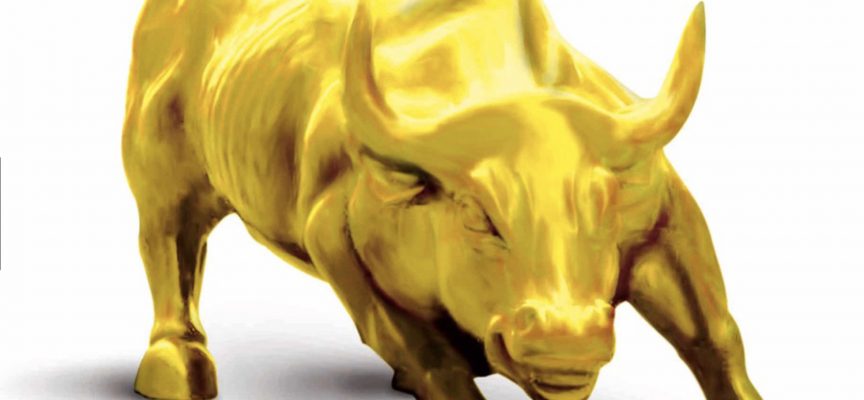As we kickoff trading in the month of December, today a legend in the business sent King World News a powerful piece stating that a fiscal hurricane will send the price of gold soaring nearly $1,000.
Gold: A Lump of Coal?

Gold’s Catalyst
By John Ing, Maison Placements
December 6 (King World News) – After a decade of monetary laxity, money and even bitcoins, fiat currencies have become a market commodity like tulips during the 1687 Dutch mania. Bitcoin has become an investment mania, made for the times and the craze has dwarfed the tech bubble. Who can trust the value today? Bitcoin or digital currencies are a man-made product created in minutes with a click. Like fiat money, there are no limits to production, no guarantor and consequently, of little lasting value. Ironically, undeterred by warnings that this electronic currency is a bubble waiting to be burst, bitcoin is a currency without a country. When investors can borrow to hedge bitcoins or when Wall Street creates the newest digital cyber-currency derivative, only then will we discover bitcoin’s intrinsic worth.
Debt, Deficits and the Dollar
For almost a decade, central banks monetized their budget deficits to finance the government of which they are a part. Their monetary laxity financed the large part of America’s growing deficits via the expansion of their balance sheets through massive purchases of government securities. Rates remained at rock bottom as quantitative easing distorted market rates of interest. Since 2007, even the Fed’s own balance sheet increased four times to a whopping $4.5 trillion (see chart below).

After three rounds of quantitative easing, America has created the biggest bubbles in history, the largest being the debt bubble. Worrisome is that in becoming the largest debtor nation in modern history, any downturn in corporate profitability could be a disaster since the corporate world also is over- leveraged…
IMPORTANT…
To find out which junior a leader in the gold mining
industry recently bought a 20% stake in CLICK HERE OR BELOW:
To date, the US benefited from this arrangement because they consumed more than they produce. For the rest of the world, they are now awash in dollars. The manufactured $10 trillion of central bank liquidity, born in the depths of the 2008 financial crisis has been the key driver pushing up asset prices to manic levels from bonds’ bull run to the subsequent record breaking stock market rally. Not a problem, until foreign investors and creditor nations decide to go on strike because they have too many dollars or, insulted by a tweet or gaffe, a Mueller charge, or the scrapping of another agreement, decide to retaliate and unload those dollars.
Debt is like cocaine. Today investors have become addicted. The Federal Reserve, responsible for credit creation has become the dominant player in the global financial system. Global growth and a decade of money printing has fueled a progression of mania or bubbles and demand for liquid dollar assets, from stock markets, da Vinci paintings, real estate to bitcoins, the bubbles have expanded in scope and risk. Some of the funds sloshed over to the corporate sector, funding buybacks, instead of investments or capex. Ironically, the tax reform bill will do little to repatriate the billions of oversea funds or stimulate capital spendings – instead there will be much more red ink despite pay-as-you-go rules. Debt cannot be solved with more debt.
Is It Different This Time?
Worrisome then is that in a world where everything looks expensive, investors’ search for yield has them taking on increased risk and leverage in order to boost returns. Central bank asset purchases also crowded out investors leaving them with riskier assets, distorting traditional valuation metrics. However, while record-breaking stock markets trumped fundamentals for investor attention, junk bond prices have collapsed and the sovereign debt market has swooned after Venezuela’s default in the biggest sovereign default in history.

As the central banks’ so-called “normalization” unfolds, we believe the first crack will surface in the debt market. Of concern, is that the present time is reminiscent of the months before the 2008 crisis. Housing is again in a bubble, Wall Street is caught up in its own rational exuberance and Americans do not save. It is not so different this time.
Central banks’ recent guidance to rein back on the monetary reins discloses an addiction to ultra-low interest rates such that a backlash has them only gradually ending these programs.
Incoming Fed Chairman Powell has cautiously spoke of halving the Fed’s balance sheet and a “steady as she goes” approach. However, pulling the punch bowl away in the form of tapering or even unwinding the large scale purchases of financial debt, will in our opinion leave an impact on the economies’ liquidity and of course, higher rates and a reaction from of those addictive to liquidity.
A year after his election, President Trump remains controversial as ever. Much was made of the implications of America’s controversial choice, yet the stock market has given a resounding thumbs up with the S&P Index up 20 percent on hopes that Mr. Trump would be a good thing for the US economy. True that the economy is growing, albeit at the same pace under Obama. However, since his election, the market volatility index (VIX) has fallen to an all time low of 0.51 percent, the lowest since the early sixties. The lack of volatility could imply a bullish view that the economic recovery is growing amidst a global upturn. On the other hand, a low volatility index preceded the biggest financial correction in 2008, as investors believed then like now, that the benign conditions would prevail indefinitely in a “Minsky Moment”.
What Could Go Wrong?
Investors have taken for granted that whatever damage Mr. Trump’s unpredictable behavior caused, the American system of checks and balances could overcome it. To date, they have been proven correct. However, Democrat successes in the November election and the overhaul of the tax code debacle has raised questions about this risky bet. US fiscal policy is the chief focus for most markets. High yield bond funds recently suffered the third largest outflow on record. The Treasury yield curve is the flattest in a decade, a condition that has inverted ahead of every US recession since the Second World War. Investors must decide whether these concerns are transitory or a warning of turmoil to come. And overlooked is what ballasts the US monetary system is debt. One of the biggest threat to an “America First” financial stability is the reckless build-up of debt. The delay of the tax cut is only the first of many disappointments. As a consequence, we expect a rethink about the US dollar, economy and of course gold, particularly when the debt ceiling comes up for discussion again as the government’s current funding expires in December.

So while the Trump “reflation” trade exists, we believe it is hanging by a thread. Amid the bluster, tweets and interventions, the greenback has weakened. We believe the recent sell-off in the US dollar reflects a growing uneasiness in the market with credit risk. And, as America turns inwards, the geopolitical climate and risk has become murkier from the Middle East (MbS’ Saudi Arabia) to Europe (Spain, Brexit, a Merkel-less Germany) to Latin America (bankrupt Venezuela). Most worrisome is that the leadership vacuum has already changed the world order. Russia and China are attempting to fill the void left by America’s retreat. China’s Xi Jinping has elevated himself to rival only Mao as China’s greatest leader. From Europe to Asia to the Middle East, other countries have focused on their priorities without US influence to limit their ambitions. The Saudi Arabia purge reflected 32- year-old Saudi Prince Mohammed bin Salman’s (MbS) move to consolidate his power, which could destabilize the Middle East. In addition, Trump’s brand of populism has spread from Austria to Italy to Turkey and worrisome is that Italian elections are looming next year. Even Berlusconi is staging a comeback.
Gold, The End of Fiat Money
Gold is an alternate investment to the dollar for central banks. It is the rational solution to an excessive accumulation of dollars. The rise in the gold price can be seen as a devaluation of the dollar. The world is awash in dollars. The Fed ironically is the world’s biggest holder of gold, and while supplies of the metal are shrinking, America’s creditors are loading up on gold. If gold is a finite currency, its value against fiat currencies
like the dollar, euro, and even sterling must rise. Gold is thus an index of currency fears. In the last 50 odd years, more and more people have unsuccessfully looked for alternative stores of values and payment methods. Under fiat currencies, we have had a series of economic upheavals from the 2007–2009 crash, the Asian crisis, the Nifty Fifty collapse, the internet bubble and of course various European crises. It goes on with regularity. Without confidence in the dollar, there is no valid reserve currency.

On the other hand, gold is a product that is thousands of years old, made by Mother Nature, and is both finite and inherently valuable. There was a time when gold was money. In today’s uncertain world, the cryptocurrency craze is a reflection of a market top in a mania-fueled world where bitcoin investment is matched only by the tulip bubble craze of 1600s. Gold is the real deal in an overvalued world. We believe the yellow metal will soon be back in fashion. Part of the allure is its traditional status as a safe haven against a world where there is quite a list of uncertainties and concerns. It is the ultimate store of value when everything seems risky.
Recommendations
Total above ground gold stocks in the world are small, at only 180,000 tonnes or less than one ounce per person in the world. Despite demand, gold remains extremely scarce. The largest share is held in jewelry form but the second largest is held by central banks. Global supplies have been squeezed with a decline in output from China, the largest producer in the world. China’s mines are expected to run out of reserves in the next few years, raising the possibility of a supply crunch particularly as Chinese demand grows even faster. China has become more open in its challenge to American financial hegemony, purchasing gold to become the fifth largest holder in the world. Russia too has made monthly purchases becoming the sixth largest holder in the world, declaring recently that any escalation of sanctions, which would freeze foreign accounts of the Central Bank of Russia, would be regarded as a “declaration of financial war”.
We believe it is the relationship between the dollar and the reaction of the world’s central banks of whom many are creditors to the US that is important. Gold’s biggest driver is a depreciating US dollar. The combined debt of governments, corporate and households are now 300 percent of global GDP. Many are still accumulating dollars that they do not want. Over the last decade, the Fed has created a risk of a sharp rise in American inflation and a precipitous collapse in the dollar.
Gold miners are facing an identity crisis. Some have written off billions of dollars and are still repairing their balance sheets. Others have made expensive acquisitions hoping that the increase in reserves would give them a growth multiple and a market following. Others however, have expanded their exploration budgets with hopes that acorns can grow into trees. However, it can take two to seven years to fully commission a gold mine from discovery to first gold pour, so that bet is for the very lucky and very patient. Moreover, the cost of extraction keeps on rising. To be sure, the lack of exploration and declining production suggests that gold supply is a major problem.
Gold Setting Up For $1,000 Surge
Technically, the group has been in a base building more for almost three years and recent activity suggests a breakout from a triangle formation. Fundamentally, cash costs have declined 20 percent from $1200 to under $1,000 an ounce, suggesting that the industry is at long last profitable. Of note is that the gold miners’ in-situ reserves are at the cheapest ever, trading under $300 an ounce on a market cap per ounce basis. We believe that in the near term, gold is headed for resistance at $1,375 an ounce which will support higher gold miner prices. We continue to believe gold will reach $2,200 an ounce within 18 months.
Speaking of gold…
In The Footsteps Of Giants
One of the top questions KWN receives from investors about the mining industry is always: “How do you know out of the thousands of companies there are to choose from which will take-off and which ones will falter?” The answer for smart money investors is always to look for proven leaders with previous success as a good indicator of future success. One individual that fits this description is pictured below with multi-billionaire Robert Friedland.

Multi-billionaire Robert Friedland chose this man to lead his expoloration team and it turned out to be a brilliant move because he was responsible for two of the largest and most important discoveries the world has ever seen while leading the team at Ivanhoe Mines. Investors across the globe are now following this man into his latest venture where he will help lead an exploration team where the CEO believes the team will deliver drill results that will send the stock price soaring more than 1,000 percent! Also, a legend in the business just made a 7-figure investment into this relatively unknown company. To get in on the ground floor and learn more about this remarkable company simply CLICK HERE.
***KWN has now released the fascinating audio interview with Egon von Greyerz, who gives his 2018 predictions and a few surprises as well and you can listen to it by CLICKING HERE OR ON THE IMAGE BELOW.
***ALSO JUST RELEASED: Things May Be About To Go Horribly Wrong CLICK HERE.
© 2017 by King World News®. All Rights Reserved. This material may not be published, broadcast, rewritten, or redistributed. However, linking directly to the articles is permitted and encouraged.









